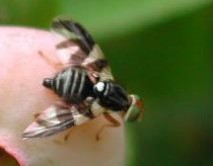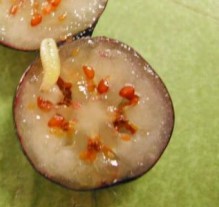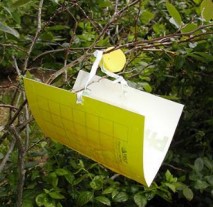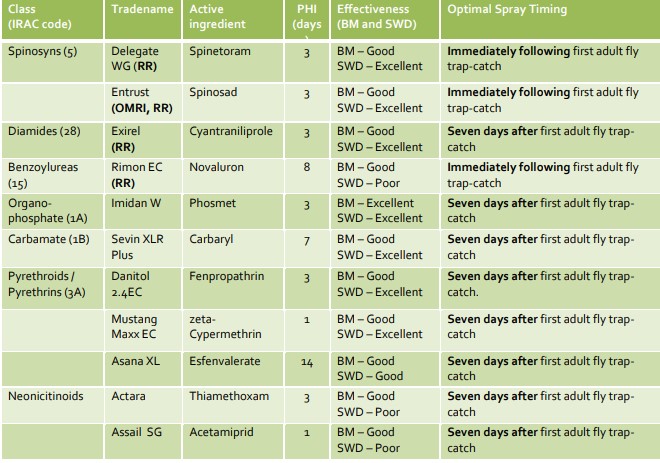Blueberry Maggot
The blueberry maggot fly was first detected in Wisconsin in the summer of 2016, and is now considered established in the state. We had reports in the last week from a couple of blueberry plantings that blueberry maggot seem to be present in Dane and Portage counties. Blueberry maggot, which is closely related to the apple pest apple maggot, can become a significant pest of blueberry, as reported for commercial blueberry production in the eastern and southern United States and eastern Canada.

So far in Wisconsin, blueberry maggot has been confirmed in Adams and Sauk counties, now suspected in Dane and Portage counties, and its range is expected to expand in coming years. If you suspect that you have found blueberry maggots, please contact the University of Wisconsin-Madison/Extension Insect Diagnostic Lab at (608) 262-6510, or email idl@entomology.wisc.edu, or go to http://labs.russell.wisc.edu/insectlab/contact-us/ . We are not formally monitoring the spread of blueberry maggot but will continue to keep you updated of its distribution as it becomes relevant.
We discussed the biology of blueberry maggot in a previous issue of this newsletter that you can access here. Briefly, the larvae develop entirely within a single fruit and damage becomes apparent in mid-July and continues until harvest. Larvae will drop to the ground, pupate in the soil and overwinter there.

Scouting Suggestions: Scouting should begin several weeks before blueberries begin to ripen (usually in early June). Commercially available yellow sticky cards, along with a feeding attractant (ammonium acetate or ammonium carbonate), can be placed at a rate of 2 traps per 5 acres. Yellow sticky cards will be most effective if folded in a V-shape with the yellow side facing down (see image at right). These should be checked as often as possible until first detection. Because the feeding attractant is not specific to blueberry maggot, there will be many other species of fly present on the card – for this reason it is important to learn to identify the characteristic wing pattern of blueberry maggot, and may be helpful to bring a hand-lens or magnifying glass into the field when you check traps.
Following first detection, if you would like to continue to scout, yellow sticky cards can be removed and replaced with green sticky sphere traps combined with a synthetic fruit-volatile lure. You can also test the fruit directly for infestation rates. To do so, collect approximately 100 berries from throughout your planting, and then spread the berries on a screen above a tray of sand. After four or more hours, you can strain through the sand to find the mature larvae or pupae that have dropped down from the berries. Alternatively, you can mix the berries with a saltwater solution, which causes maggots to float out of the berries.
Control: Some cultural control methods can help prevent blueberry maggot infestations. These include:
- Removing weeds in the blueberry patch, as these can provide habitat for blueberry maggot.
- Removing wild blueberry and huckleberry alternate-host refuges near your plantings.
- Harvesting thoroughly, and solarizing or freezing any damaged or unsalable fruit. Never compost crop waste without first solarizing it, as blueberry maggot pupae can survive in the compost and infest crops in future years.
- Being careful to clean soil away from any equipment or honeybee hives that are moved between blueberry farms, so as not to introduce blueberry maggot pupae in the soil.
Chemical control is recommended if you find on average more than one blueberry maggot adult per trap for several days in a row. In general, spraying should begin about a week after the first blueberry maggot flies appear in your traps, and should continue every 7 to 10 days through harvest. Some of the reduced-risk chemistries, such as Rimon, Delegate, and Entrust, are most effective when used as soon as flies are found in the traps.

Because you will need to spray while berries are ripe, it is especially important to pay attention to the pre-harvest interval when choosing which chemistry to use. Additionally, it may be beneficial to choose an insecticide that also shows efficacy against spotted wing drosophila. As always, it is recommended to rotate IRAC chemical classes to delay insecticide resistance, and to consider the effects on non-target and beneficial insects.
The following insecticides are registered for use in blueberries in Wisconsin. The list is not inclusive of all chemistries that can be used against blueberry maggot, and does not signify that we recommend these insecticides above others. As always, be sure to read and follow label directions for the most up-to-date legal requirements and recommendations.
Effectiveness codes are for blueberry maggot (BM) and spotted wing drosophila (SWD), and are designated as “excellent”, “good”, or “poor” levels of control.

OMRI indicates registered by the Organics Material Review Institute as organic certified. RR indicates reduced-risk chemistry.
This article was posted in Berries, Insects and tagged blueberry maggot.
